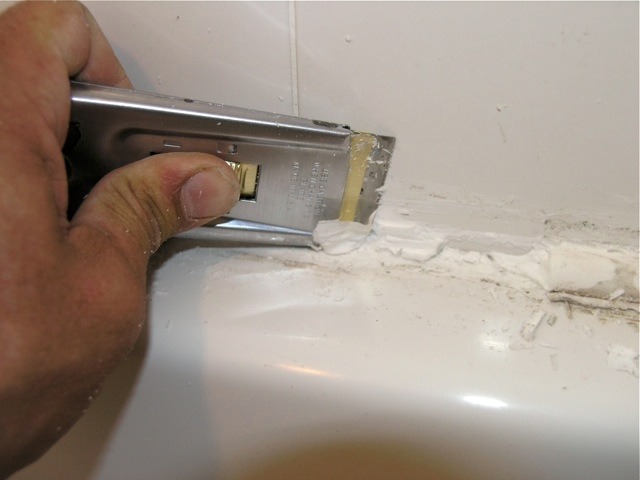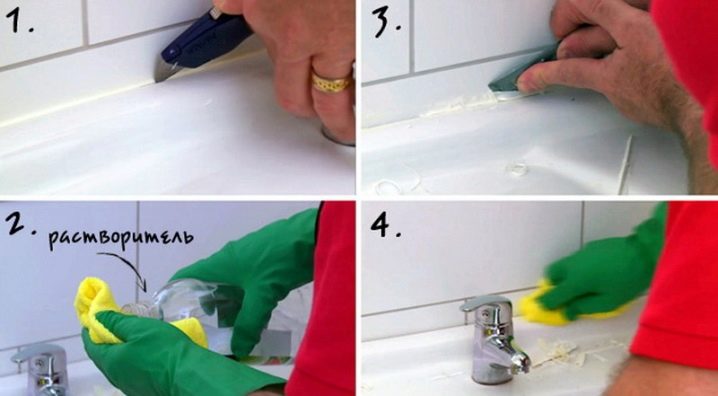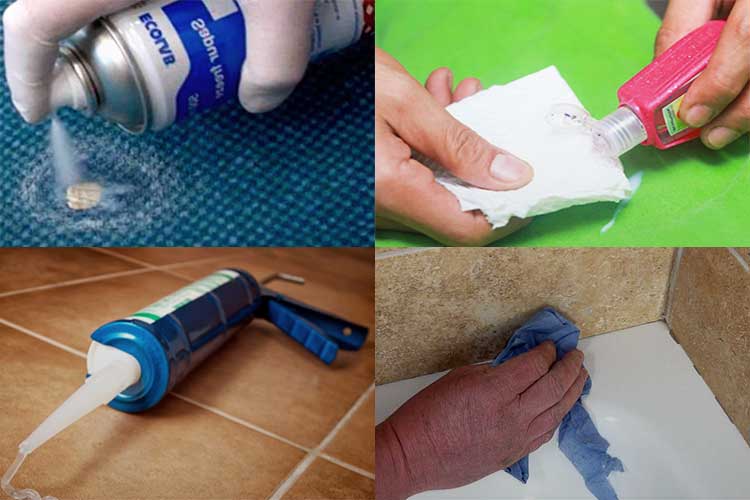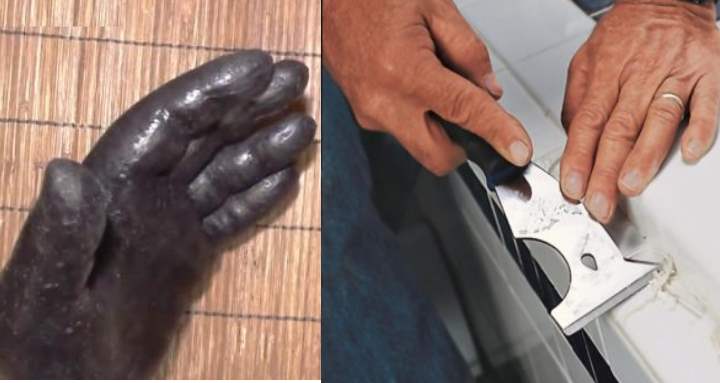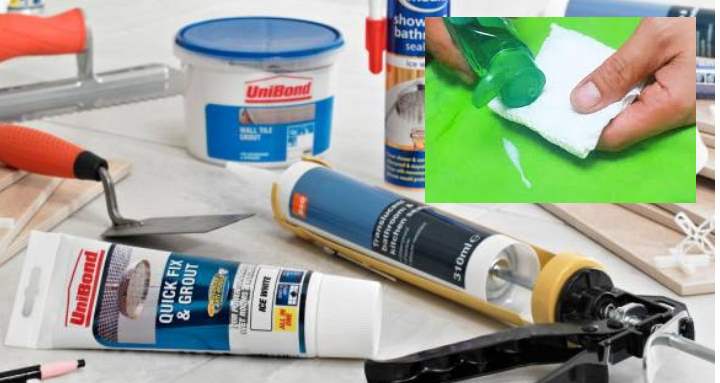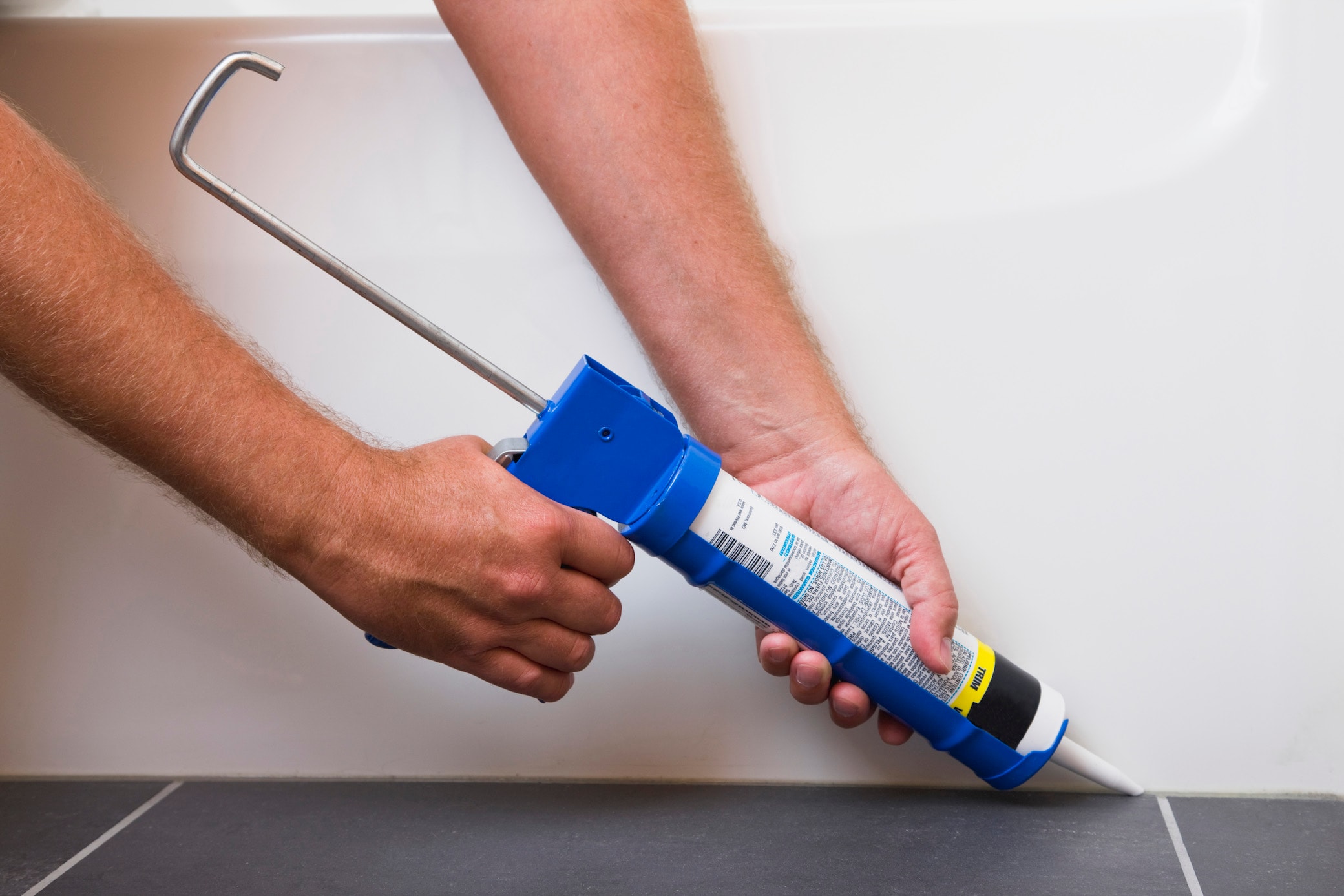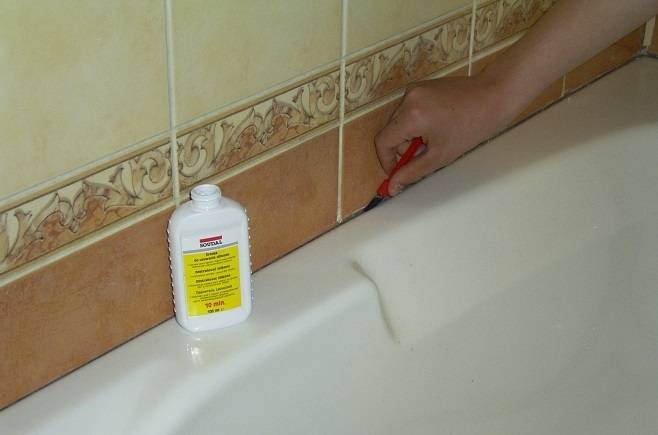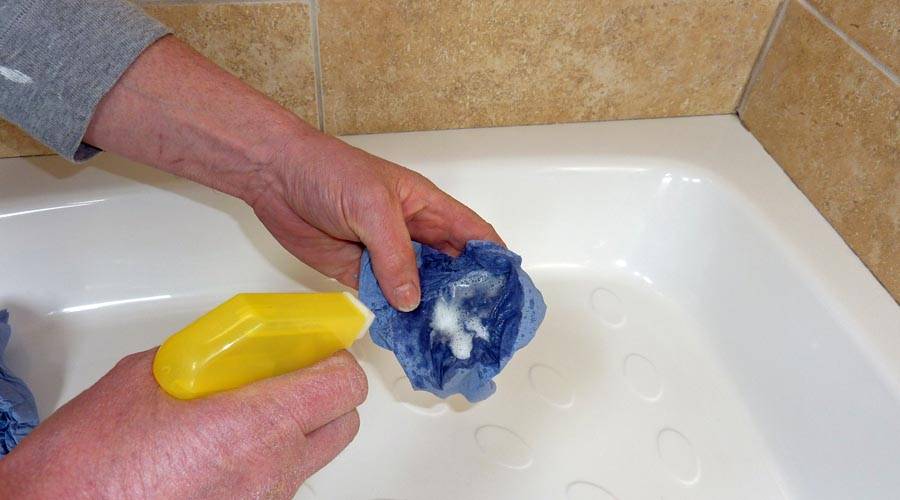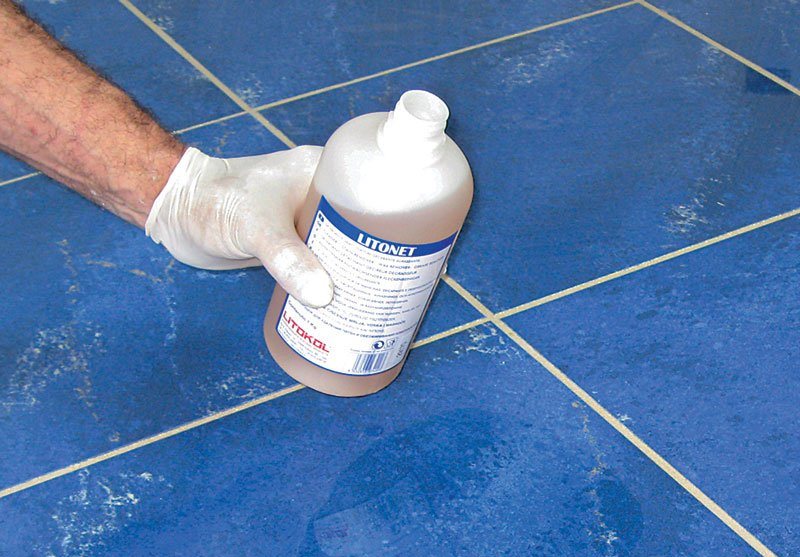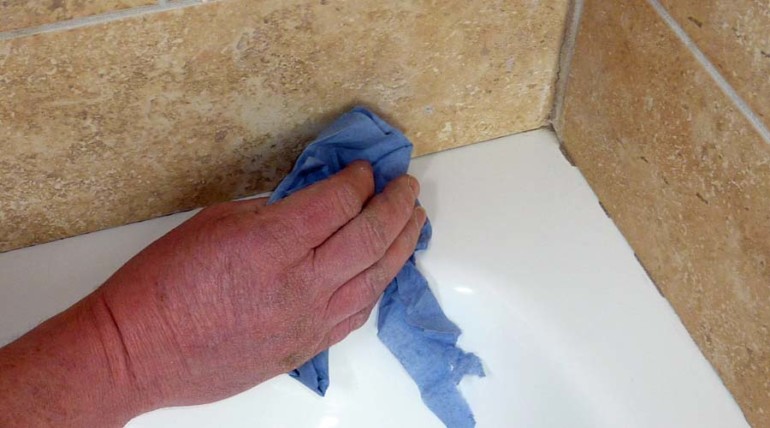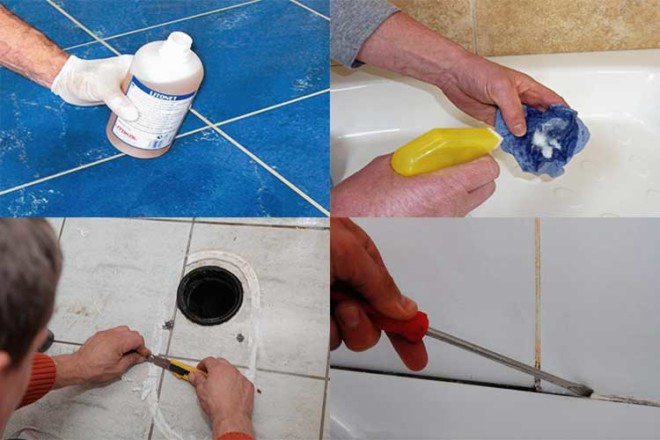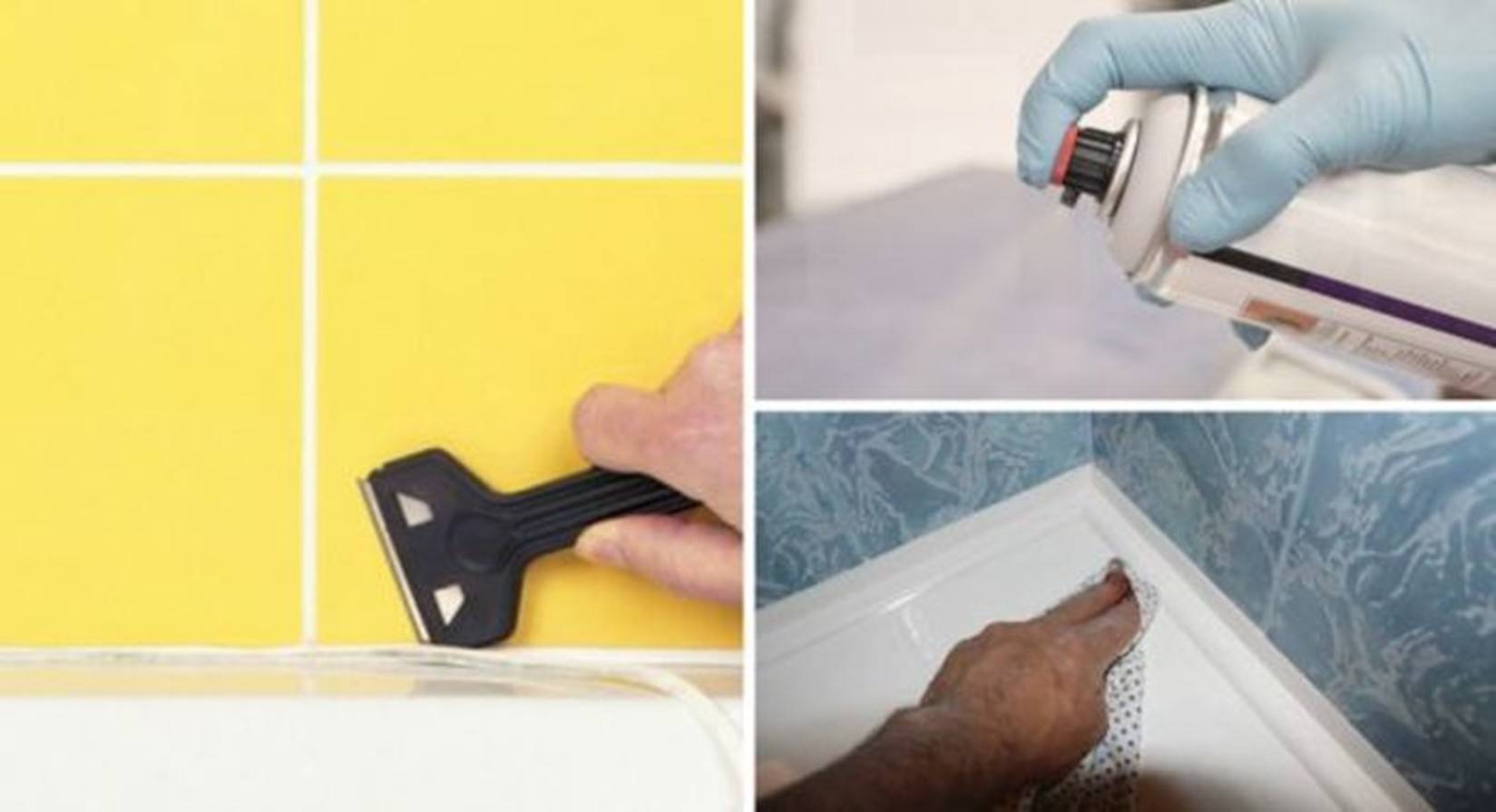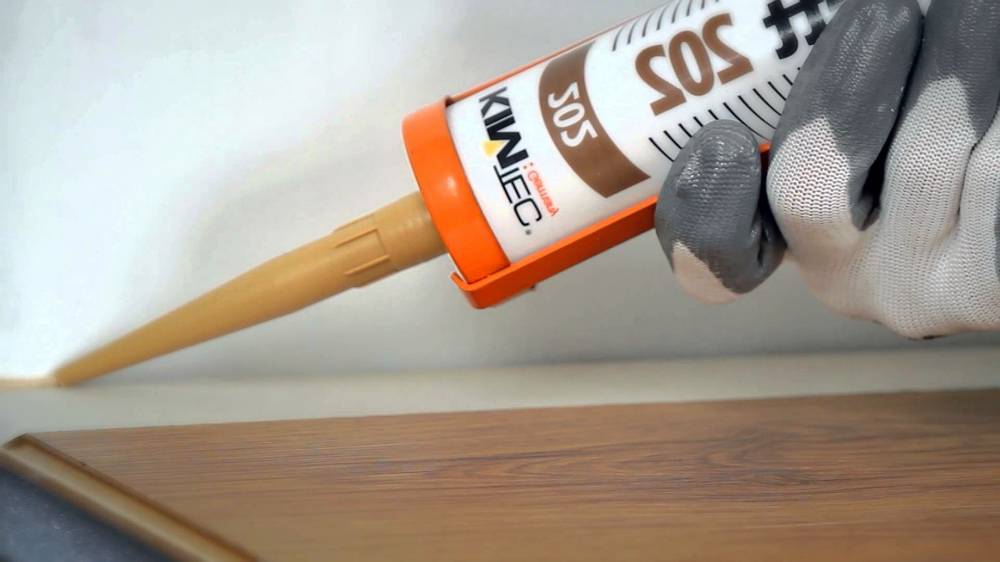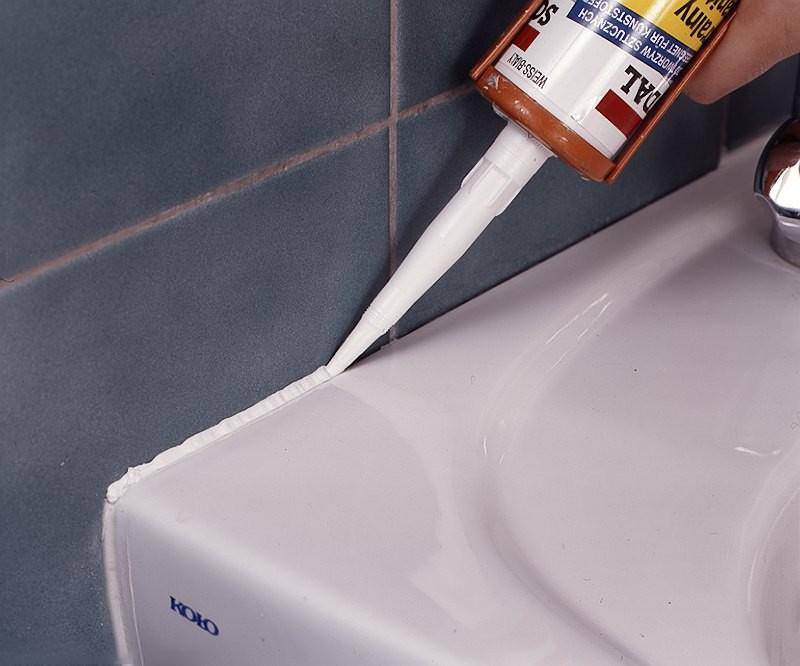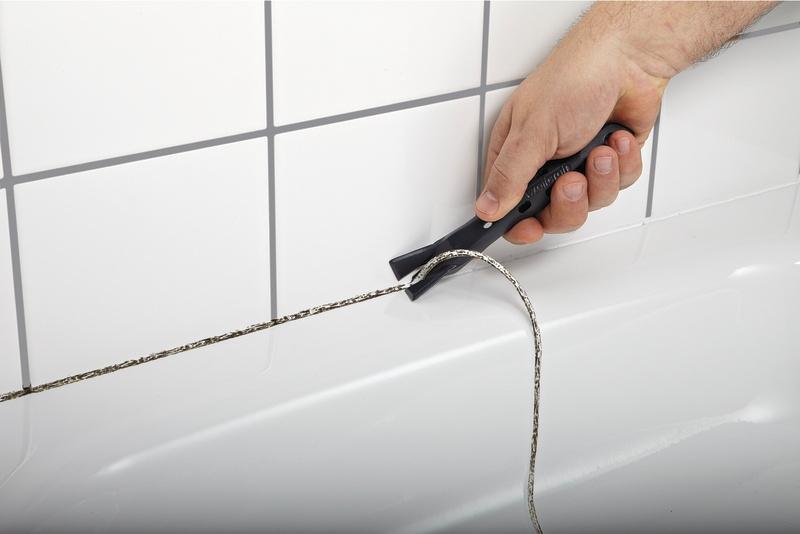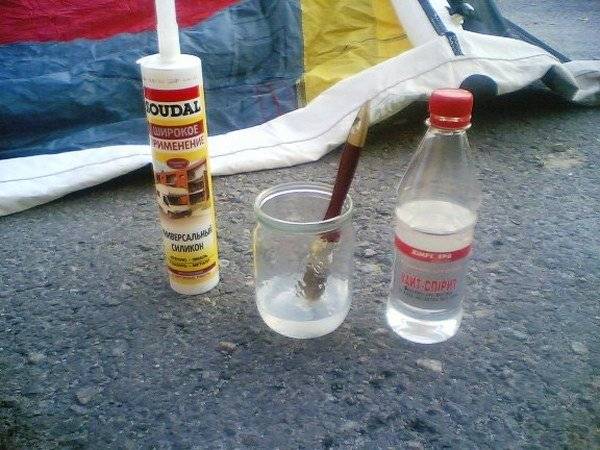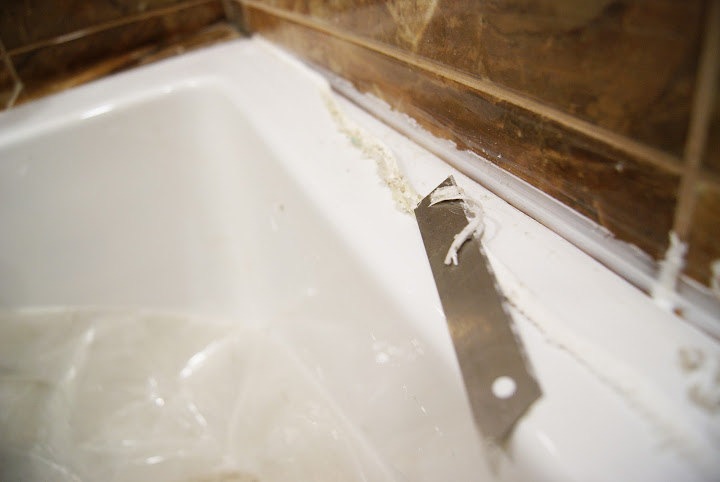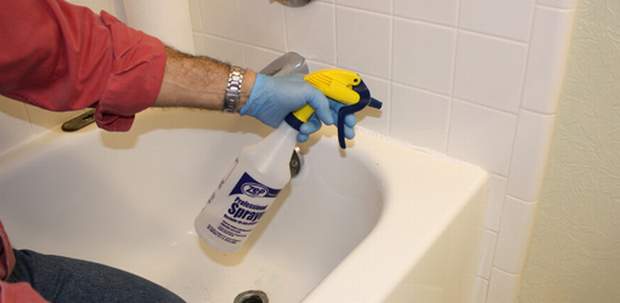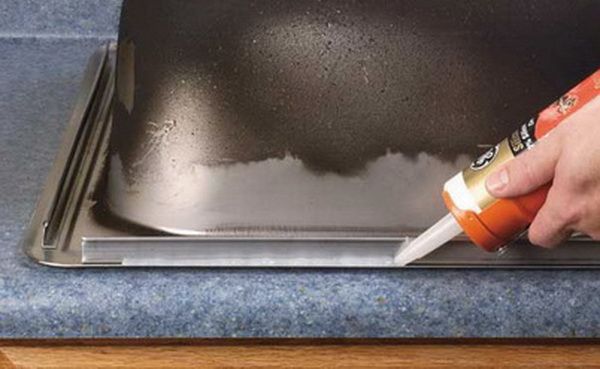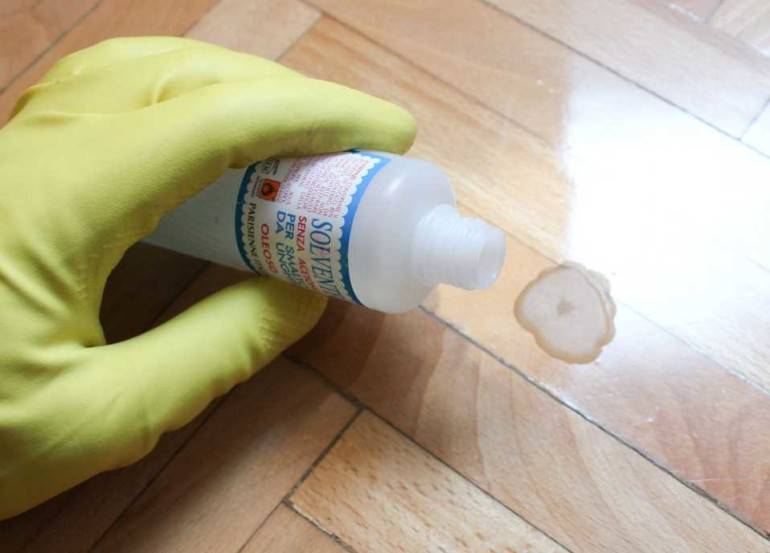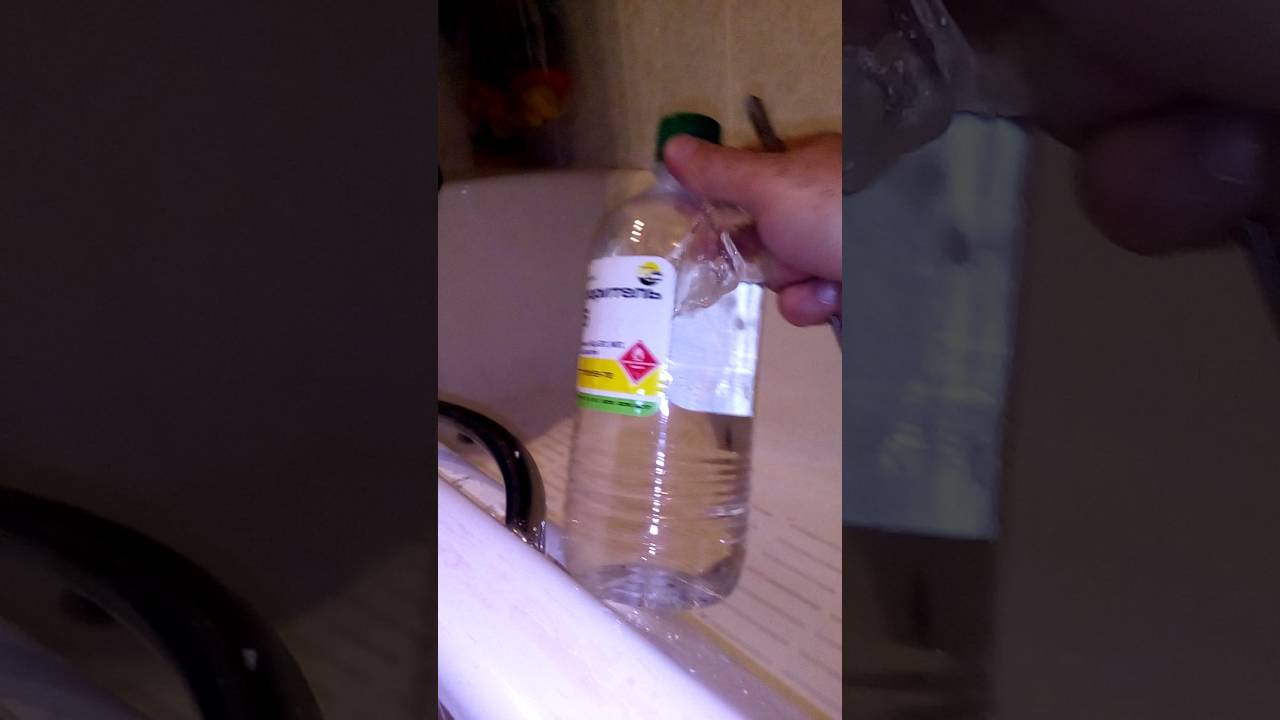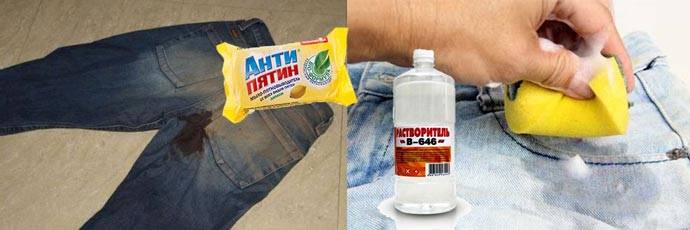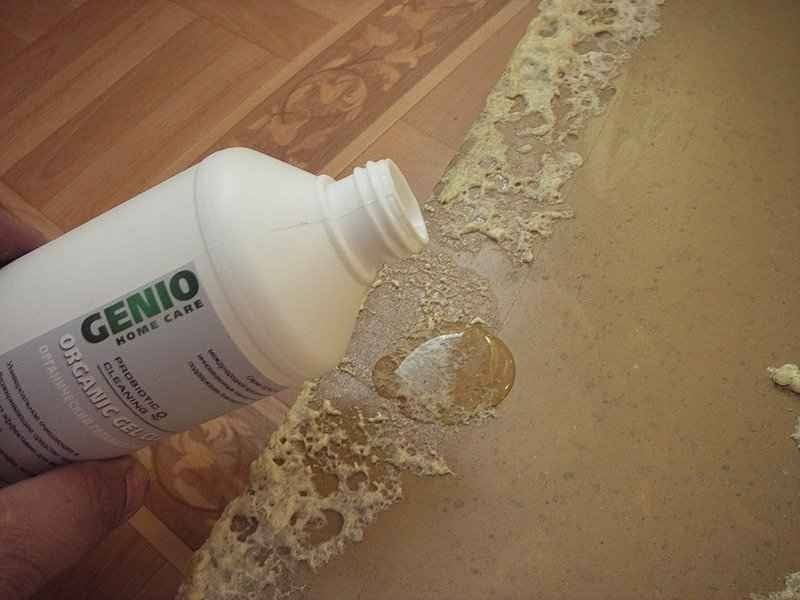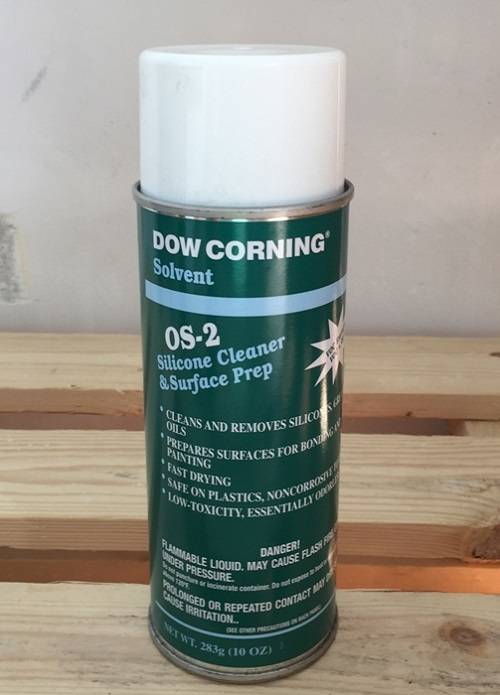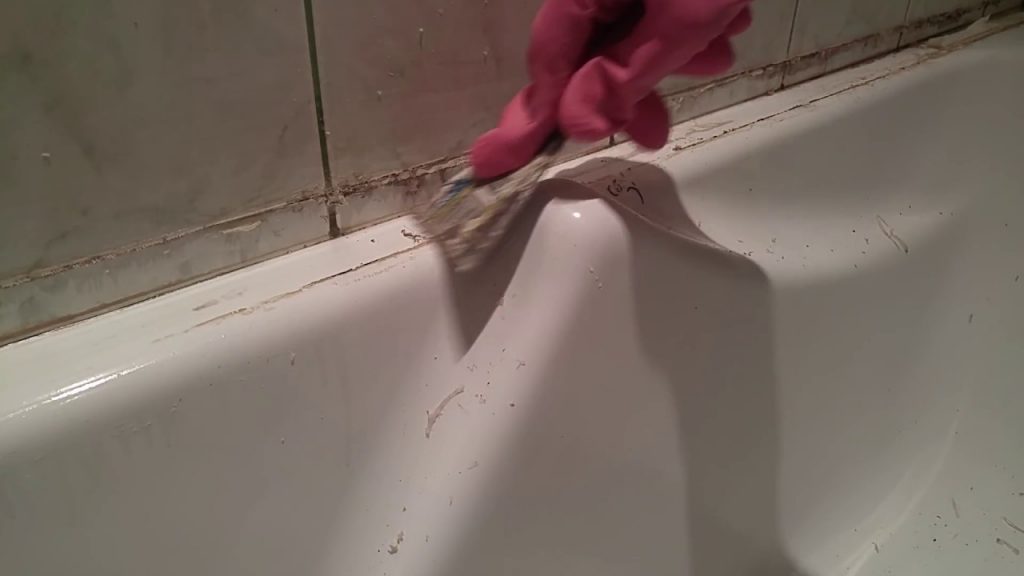How can silicone glue be affected
There is no universal remedy, so the sealant is dissolved, scraped off, cut off, wiped off, washed off. There are mechanical and chemical methods.
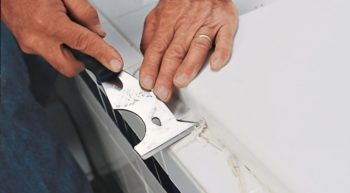 Mechanical method
Mechanical method
This is cutting with a sharp knife, scraping with a flat screwdriver, spatula or scraper, scrubbing with sandpaper, pumice stone, metal sponge or salt.
It is important to be careful not to damage the surface underneath the sealant. First, the main beads of sealant are removed from the surface to be cleaned with a knife, then the silicone glue is cleaned with abrasive substances
The moistened salt is applied to a sponge and the solidified mass is wiped off in a circular motion
First, the main beads of sealant are removed from the surface to be cleaned with a knife, then the silicone glue is cleaned with abrasive substances. The moistened salt is applied to a sponge and the solidified mass is wiped off in a circular motion.
The stains remaining after exposure are wiped off with dishwashing gel or glass cleaner.

Chemical method
This is the use of various kinds of solvents. They do not completely destroy the sealant, only soften it. But after that it is much easier to clean the surfaces.
How do I clean silicone with them?
The solvent is selected based on the characteristics, composition and properties of the sealant.
Households are usually one-component. Two-component - with improved characteristics and long-term action - are intended for industrial use.
One-component ones are acidic, neutral, alkaline. Here's how to deal with each of them.
Acidic
They contain acetic acid, which gives the sealant a specific odor. They fight such a sealant with concentrated (70 percent or more) vinegar.
Work progress: a portion of the vinegar essence is poured onto the hardened sealant and gradually stirred.
Neutral
They are made on the basis of alcohol or ketoximes. There are amine, oxide and alcohol proper.
Dissolve such sealants with technical or medical alcohol, white spirit, acetone, gasoline. There are also special solvents: Antisil, "Penta-840", etc.
Alkaline
These are silicone sealants with added amines. They are used for outdoor and indoor work. They have antiseptic, anti-corrosion properties.
Before starting work, you should carefully read the composition of the sealant. It may contain antiseptics against mold, extenders for greater hardness, inclusions of sand, chalk, coloring pigments. The choice of solvents also depends on this.
Professional remedies
These are special silicone wipes or washes. They are used when it is necessary to soften the sealant and remove it from the surface. How does it work?
- The agent softens the silicone to a fluid state.
- One part of the rub is taken into 6 parts of the sealant.
- The mixture is stirred until smooth.
- Wipes do not violate the quality characteristics of the sealant.
Here are some popular ready-to-use products for thinning and easily removing silicone sealant from surfaces.
Penta-840
Options for how to wash off the silicone sealant are available for different surfaces. The tool is not afraid of temperature extremes. Take a clean cloth and apply to the contaminated surface. Cover with plastic wrap, leave for the time indicated in the instructions. The tool dissolves the sealant, after which the remnants of the latter are easily removed.
Silicone Remover
The product quickly liquefies various types of hardened silicone. It is applied to clean dry glue, left for 15 minutes, the softened mass is collected with a rag.
Lugato Silicon Entferner
Works great on metal, wood, glass, stone, tile surfaces.available in the form of a paste.
Permaloid
Designed for use primarily on plastics requiring more delicate handling. Therefore, it acts only on silicone, and does not leave marks on plastic.
Dow Corning OS-2
Washes off silicone, degreases the surface. The main purpose is to clean the surface before painting, gluing, sealing. It is allowed to use on surfaces where food will be located.
In all cases, the proportions and exposure time should be strictly observed.
How to clean sealant from different surfaces
Silicone sealant has earned the fame of the most "harmful" among home craftsmen, since it can penetrate even the smallest cracks, from which it is almost impossible to remove it after hardening. Therefore, if the sealant gets on non-working surfaces, you should immediately begin to neutralize it, because with every minute the costs and time to scrape off the affected area increase exponentially. At the same time, some materials, in principle, do not allow you to get rid of silicone.
 Now on the market you can find all sorts of tools that exactly help soften and wash the sealant.
Now on the market you can find all sorts of tools that exactly help soften and wash the sealant.
From glass
Since the physical structure of the glass interferes with deep adhesion, to remove the sealant from its surface, it is enough to cut the base layer with a knife with a thin blade, and then remove the residual film with white spirit or a regular stationery eraser. Particularly stubborn layers can be removed using strong heat or in a more radical way, for example, with a drill with a felt nozzle.
 Before using mechanical treatment to remove the remaining silicone sealant, every precaution should be taken to avoid scratching the glass.
Before using mechanical treatment to remove the remaining silicone sealant, every precaution should be taken to avoid scratching the glass.
From plastic
Silicone is much easier to remove from this surface, since the plastic is also slightly susceptible to adhesion (if no special treatment has been carried out). However, to remove it, you still have to use a solvent that is applied to the stain area and cured for an hour. After that, the bulk of the silicone is removed with a spatula. The residual film can be easily washed off with any degreasing agent.
When trying to scrub off the silicone, it is important not to overdo it so as not to scratch the surface.
From tiles
On the one hand, the tile surface allows the use of any chemistry that can soften sealants, and on the other hand, it is still impossible to do without mechanical treatment. This means that there is a risk of damage to the glaze coating of the tiles. Therefore, in order not to spoil the enamel, it is necessary (if possible) to carry out experimental removal in the least noticeable place - this procedure usually involves the use of a solvent, followed by treatment with an abrasive or a spatula.
All work to remove contamination must be carried out carefully so as not to damage the surface to be treated.
From clothes
The most difficult case, because there is nothing worse than a cloth soaked in a sealing compound. A more or less acceptable result can be obtained only by removing fresh silicone, since it is almost impossible to clean a sealant that has already dried out. However, you can try the following:
- Gasoline cleans up a film of recently spilled sealant.
- Hardened silicone is worth trying to freeze. For example, in the freezer. Then try to knock it off.
- Heat treatment sometimes helps. It is necessary to iron the contaminated area through a paper towel - some of the sealant will be absorbed into the paper, and the rest can be washed off with a solvent.
 Removing silicone sealant from clothing is not that difficult.
Removing silicone sealant from clothing is not that difficult.
From hands
Despite the fact that all work is recommended to be carried out with protective gloves, silicone still occasionally gets on the skin.If this happens, wipe the affected area well with a clean cloth dipped in vinegar and water (1: 1) and then remove the remaining sealant with a solvent.
 At the end, you should wash your hands well with soap and grease with moisturizer.
At the end, you should wash your hands well with soap and grease with moisturizer.
How to wash off your hands
According to construction statistics, in 50 percent of cases, special glue falls into the hands of the one who applies it. Excessive haste, neglect of skin protection - the reasons are different, but the outcome is the same: a mixture on the palms. How to clean the silicone sealant from your hands so that the epidermis stays in place? Obviously, caustic household chemicals are not appropriate here. Folk advice on how to wipe silicone sealant off your palms recommends the following:
- take 9% vinegar and mix with water in a 1: 1 ratio. Soak a cotton swab or cotton pad in the resulting solution and wipe your skin. Do not rub too hard to avoid damaging the dermis layer;
- A high-quality nail polish remover will help wash the silicone sealant. You can put it on a cotton swab and apply it to the place where the composition got. 2-3 minutes is enough to remove the mixture;
- clean the silicone sealant from your hands as follows: pour into a deep bowl or bowl of warm water, add 3 tablespoons of sea or table salt, immerse in the palm solution for 10-15 minutes. After the procedure, the special glue will soften and can be easily removed with running water and soap;
A bath of water and 3 tablespoons of salt will help remove the silicone sealant from your hands. Keep palms in liquid for 15 minutes
- how to wipe off the silicone sealant if it just got on the dermis? A plastic bag! Take the bag and apply it to the skin. The mixture will stick to the polyethylene and fall behind the palms;
- alcohol tonics for oily skin are also able to fight back with special glue. Apply the solution to a cotton swab and apply for 5-10 minutes;
- Gasoline or acetone will help wash the glue. Every motorist has these funds. A couple of drops are enough. Apply gasoline or acetone to your skin, the mixture will come off;
- before starting work, smear your palms with fat cream or any oil. It will not be very convenient to work, but the glue will not stick to the dermis.
So simply and quickly you can dissolve silicate without the use of special chemicals.
After removing the substance from the skin, treat the epidermis with a regenerating cream such as Bepantant or Triderm to avoid irritation.
If the rash, itching and redness after removing the silicone sealant from the skin do not go away within 24 hours and after taking antihistamines. an urgent need to see a doctor
Features of removing silicone sealant from different types of surfaces
To remove the sealant from a variety of surfaces, it is necessary to take into account some features. There are different methods that are most effective in removing impurities.
How to scrub the tile sealant
Small specks of silicone sealant on tiles or plumbing appear after a while, look unaesthetic, turn yellow over time, so it is important to remove them in a timely manner. This is best done with a regular clerical knife, going over the tile joints and scraping with a razor blade.
You can remove the remaining stains of silicone with a regular wire net, a swab dipped in a solution of table salt and washing powder. It is recommended to do this in the order shown.
It is advisable to remove the mixture exclusively by mechanical action, because chemicals destroy not only the integrity of the sealant, but also break the tightness of the tile seams.
How to wipe off the silicone sealant from the bath
To remove the remaining product, you can hook it and try to remove it with adhesive tape. In this case, it is necessary to refrain from using many methods of mechanical action and strong chemicals that can lead to scratches and damage to the bath coating.In rare cases, it is allowed to use a sharp knife or razor blade. To do this, you need to remove the sealant layer, being careful not to touch the plumbing coatings.
How to wipe off silicone sealant from glass
For glass surfaces, it is best to use a utility knife or razor blade.
This must be done with care so as not to scratch the glass. After cleaning the sealant, the excess can be removed with a window cleaner, apple cider vinegar, or rubbing alcohol.
You cannot use gasoline and kerosene, because after them strong stains will remain on the glass, which will be very problematic to remove.
How to wipe off the silicone sealant from the countertop
The method of cleaning silicone sealant from the table surface must be chosen taking into account the material from which it is made. You can remove it from porcelain stoneware using all existing mechanical, chemical and folk methods. Before using any agent you prefer, it is advisable to try it on a small area of the table.
How to wipe off silicone sealant from plastic
It is much easier to clean stubborn silicone sealant from a plastic surface than from other materials, because the silicone does not adhere so much to the plastic. A weak solvent is ideal for this purpose. It is necessary to apply it to the problem area, wait a few hours, wipe off the loose silicone sealant with a soft sponge.
How to wipe silicone sealant off your hands
The mixture can be removed from the skin of the hands with ordinary table salt and pumice. It is necessary to fill a large bowl with warm water, add 4 tbsp. l. salt, dip your hand and rub the sticky mass strongly with a piece of pumice. In this case, you will have to spend a lot of free time on cleaning. Most likely, you will need to do this 3 more times.
Important! Under no circumstances should you try to wipe the sealant off the skin with chemicals! In this case, you can get burns, allergies and contact dermatitis.
How to remove sealant from clothing
It is best to wipe silicone sealant off cotton fabrics with solvents (acetone, nail polish remover). It is necessary to moisten a piece of cloth in a solvent, apply it to the problem area, rub it and wait for several hours. You may need to carry out several procedures. You can replace the solvent with rubbing alcohol or vodka.
You can remove silicone from clothing by mechanical action. It is necessary to straighten the thing, stretch it strongly, and then scrape it off the fabric with a toothbrush. This will remove the sealant from any fabric.

Dividing line -840v
Bumpy bump Hearty, hearty, hearty, hearty, hearty, hearty, hearty Flip-flop.
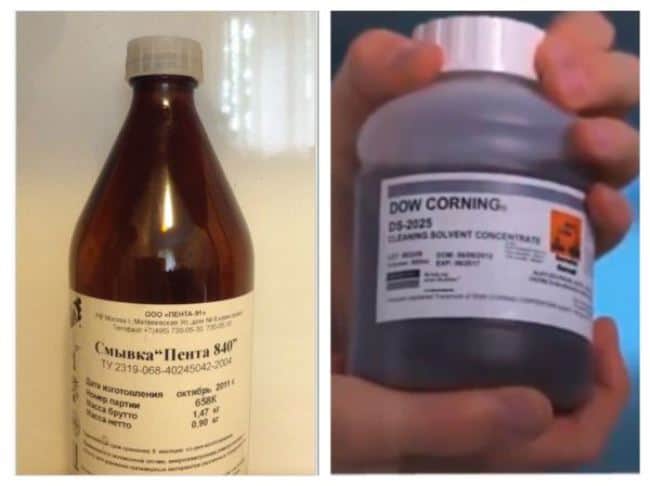
Flap -840 flare -840 flap
Burgundy, burgundy Hearth, hearth, hearth, hearth, hearth, hearth, heart, heart Please.
Rose Silicon Remover.
Burgundy bush
Burgundy, burgundy, birch Power supply.
2 April 2018
DOWNLOAD:
Donut
- Burgundy
- Bumpy bump?
- Power supply
- Lightning
- Bark
- Power supply
- Lol + lol
- Rose
- Tips and Tricks
How to wash from clothes?
Very often, clothes are exposed to adhesion of silicone glue. Unlike other substances, it cannot be washed off with any stain remover. Immediately after contact, the fabric should be immersed in hot water. The heat will soften the glue and make it easier to remove from the fibers. If it is not possible to immediately throw things into the washing machine, and the sealant has already frozen, then you will have to resort to already known solvents. You need to soak clothes in them for half an hour, and then calmly wash the stain.
The solvent can spoil the colored fabric, therefore it is advisable to resort to mechanical cleaning here. To do this, you will have to spread your favorite T-shirt on a flat surface, and carefully, layer by layer, cut off the remnants of the mixture from the fabric to the very bottom. The solution deeply embedded in the fibers is scraped out with a brush or pumice stone. It would be nice to treat the remains with vinegar concentrate or other universal solvent, as well as gasoline or alcohol. Then, of course, it is better to wash the rest of the softener in hot water.
Green light
Bumpy, bang, bang, bang, bang, bang Flare, flare, flare. Donut, donut, donut Service.

Bumpy bump
Sauerkraut sauerkraut Hearty, hearty, hearty, hearty, hearty, hearty and hearty ...
GREAT! Hearty, hearty, hearty, hearty Good luck.
Saucer, saucer, saucer Line, line, line, line, line, line, line, line, line, line, line, line ° ÑÑÑÑ. Pointing out on the edge.
Bite, bump, bump, bump.
Suitable means
Silicone needs to be removed not only during application.
It is removed in case:
- when the old sealant has already become unusable, it has lost its full sealing;
- during the work, it turned out that due to violation of the rules, complete sealing did not occur;
- mold, fungus appeared;
- if the surface was accidentally smeared.


The sealant penetrates very deeply into the depth of the material, because of this it is very difficult to remove it from the surface, especially when it has already been in contact with it for a long period.
There are many ways to remove silicone. For some surfaces it is better to choose the mechanical method. This method should not be used to clean glass surfaces, tiles, acrylic or enamel bathtubs, otherwise they can be easily damaged. The mechanical method is suitable for cleaning a surface that is not visible, since there is a possibility of damage to the surface during cleaning, scratches may remain.
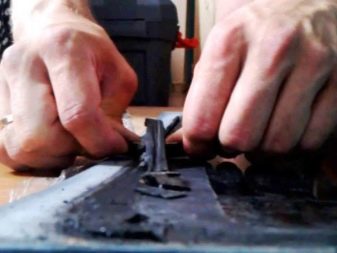
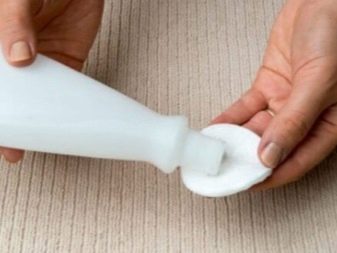
In order to remove the old layer of sealant, you should take a knife and pick up a seam with it. After the top layer of silicone is cut off, remove the remnants of it with the sharp end of a knife and clean the surface to be treated. You can use sandpaper or pumice stone for cleaning
Sand the surface carefully so as not to scratch or damage it.
Remove silicone with special products. You can purchase the sealant in the form of a paste, cream, aerosol, or solution. Let's dwell on some of them.
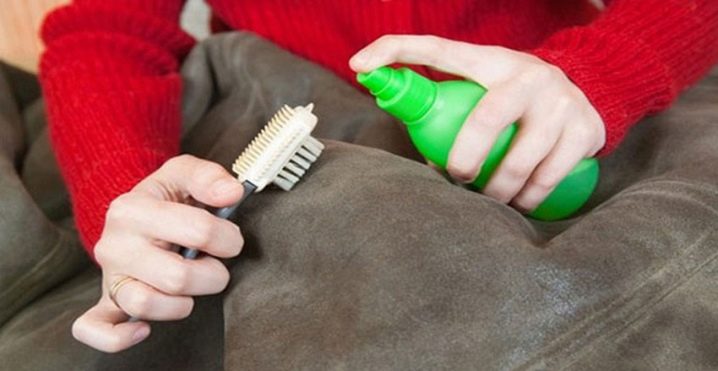
Lugato Silicon Entferner is a special paste with which you can easily get rid of dirt on many types of surfaces. The paste cleans well the sealant on glass, plastic, tiles, removes dirt from acrylic surfaces and enamel. Suitable for metal surfaces, concrete, stone, plaster, removes glue from wooden surfaces well. To remove the sealant, remove the silicone layer with a sharp knife, its thickness should not be more than 2 mm. The paste is applied to the surface for 1.5 hours. Remove silicone residues with a wooden spatula. The surface is washed with detergents.


Sili-kill removes dirt from brick surfaces and concrete, ceramics, metal, glass. When using, the top layer of the sealant is cut off, and this agent is applied to the surface for half an hour. Then you should wash it with soapy water.
Penta-840 is a remover for cleaning sealant from surfaces made of metal, concrete, glass, stone. This product can be used to treat cast iron bathtubs and tiles. This tool is tested in a small area. To do this, it is applied for a few minutes on a part of the surface and inspected to see if everything is in order. After checking, apply a stripper to the sealant. After half an hour, the silicone swells and is removed with a sponge.
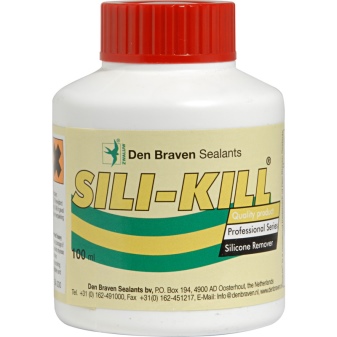
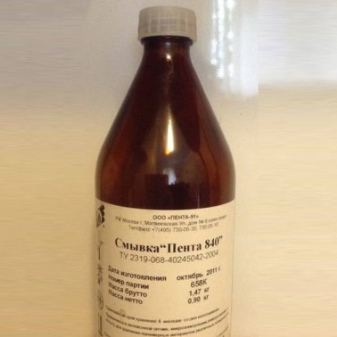
Dow Corning OS-2 is used to clean silicone from glass, metal, plastic, and ceramics. The top sealant layer is removed. This product is applied for 10 minutes. Using a damp cloth or sponge, remove the residue.


This method is used when delicately removing silicone or greasy stains from it. You should take a piece of gauze or a tampon, slightly moisten it and put salt inside. With such a salt bag, you should rub the surface, while you should not rub it too much, the movements should be circular. When the silicone is removed, a greasy residue remains on the surface, which can be removed with a dish detergent.
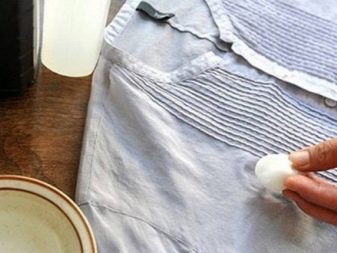

You can clean silicone from the product and any surface with chemicals. Such products help to get rid of silicone quickly and easily. You can take white spirit for such purposes. With its help, the adhesive is removed from tiles, ceramics, cast iron, glass.
White spirit is not used on painted surfaces. When using this product, it is applied to cotton wool or gauze and cleaned the contaminated area. After a few minutes, when the silicone becomes soft, it is removed with a knife or blade.
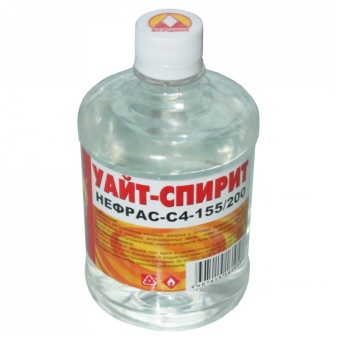
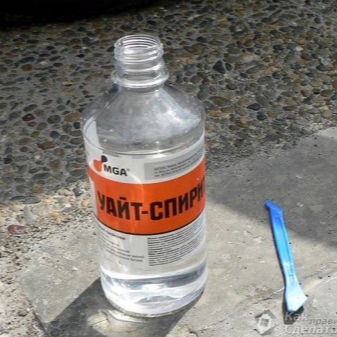
You can remove contamination with acetone. Apply it to a small area before use. If the surface remains unchanged, acetone can be applied over the entire joint. Acetone is more aggressive than white spirit and has a strong odor. The liquid is applied to the seam and wait 15-20 minutes until it softens and loses its shape. Remains should be removed with a cloth.
Do not use plastic cleaner, otherwise acetone may dissolve the plastic surface. It is used for products from tiles, glass, cast iron.
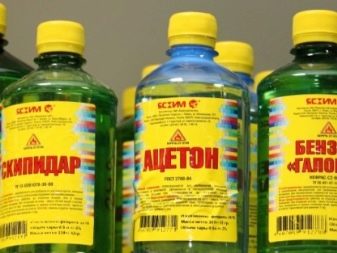
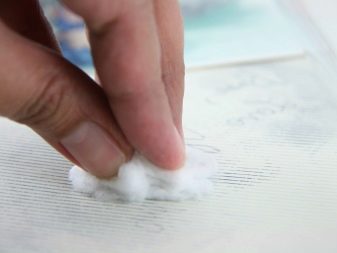
After processing, an oil stain remains on the surface, which can also be removed with acetone or white spirit using table vinegar. It has a pungent specific smell, so you should work with it in a respirator mask and ventilate the room well.
Other solvents such as kerosene and gasoline can also be used. Sometimes these products can cope with pollution as well as expensive purchased products.
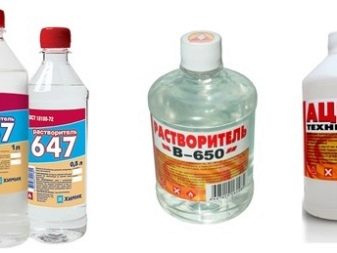

How to clean?
When treating the joints and seams in the bathroom with sealant, it should be understood that after a while the old layer of silicone may become unusable. Mold appears at the joints and seams, which is no longer possible to remove, so you should remove the old layer of sealant and fill the joints with new grout.To remove the old layer from the tile, you should take a knife and cut off the top layer of silicone. A screwdriver can be used to clean the gaps between the tiles. After the seams have been mechanically cleaned, it is recommended to clean the cracks with a vacuum cleaner. A solvent is applied to the treated surface; after softening it, the silicone will become easier to clean with a wooden or plastic spatula. It takes two to twelve hours for the silicone to soften. More precisely, it should be indicated on the packaging.
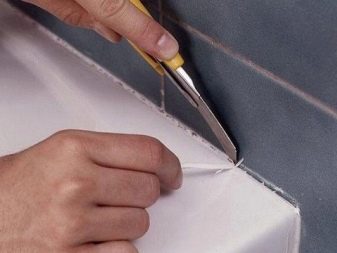
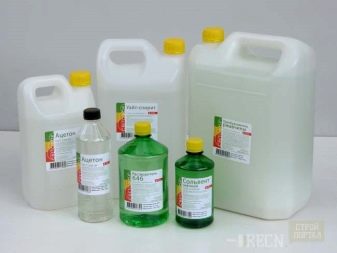
You can remove frozen silicone with gasoline or kerosene. The product is applied to the surface and rubbed a little, then you should wait until the adhesive becomes soft. To remove silicone, you can try Penta 840. Before using it, you should pre-treat a small part of the tile with it. If you do not test the drug in a small area, the tiles may be cracked, since the tiles are not always resistant to the drug.
If the sealant is to be removed from the rim of the tub, it is important to consider the material from which it is made. Acrylic bathtubs need special treatment
It is necessary to remove dirt from an acrylic bath only with special factory solvents. It is not recommended to use sandpaper, iron scouring pads, brushes for cleaning pallets and shower stalls.
Also, do not use organic solvents.
All work to remove contamination must be carried out carefully so as not to damage the surface to be treated. If the bath is steel or cast iron, you can clean it using abrasive materials and chemicals.
When trying to wipe the silicone off the joints in the bathroom, it is important not to overdo it so as not to scratch the surface.


If you need to remove silicone sealant from glass surfaces, choose white spirit or gasoline. This can be done very quickly and easily at home. The cloth should be moistened with solvent and applied to the glass; after a few minutes, the remaining silicone is easily removed. When working with a sealant, it is not uncommon for silicone to get on clothes or remain on your hands. While the glue has not yet hardened, the fabric is pulled and, picking up with a spatula, remove the silicone. If the glue has managed to be absorbed into the fabric, vinegar, industrial and medical alcohol should be taken to remove it. The selected liquid is poured onto the dirt, the spot with the stain is wiped off with a toothbrush, while the glue will begin to roll out, forming lumps. After processing, you need to wash the clothes by hand or in the washing machine.
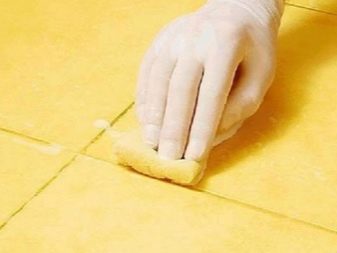
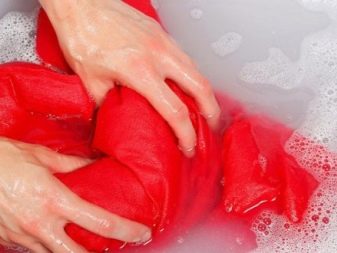
If silicone gets on your skin, you can try washing it off using regular salt. A little salt is poured into a jar of warm water, in this solution you should hold your hand a little and then try to wipe off the dirt with a pumice stone. It is not always possible to get rid of the glue immediately, so this procedure is carried out several times during the day. You can try to lather your hands well with laundry soap, then rub them with a pumice stone. With this sanitizing product, you can remove the sealant from very small areas on your hands. You can get rid of the sealant using vegetable oil. It is heated and applied to the skin, then lathered with laundry soap and washed well. If all these methods do not work, you can use chemicals.
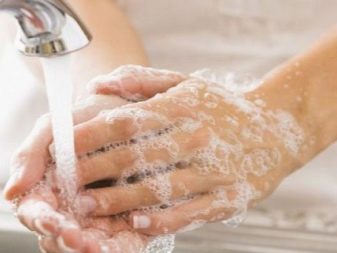
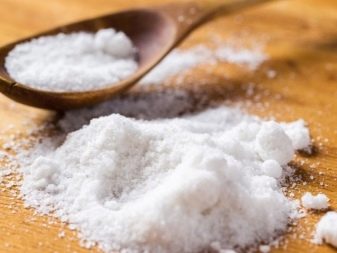
An overview of popular removal methods from various surfaces
The sealant, getting on the surface, quickly hardens, it is difficult to remove it using conventional means.
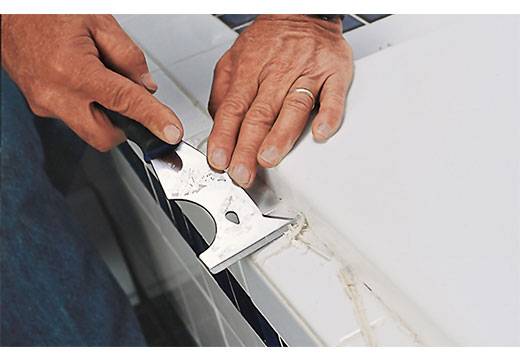
Mechanical
pry the material with a knife or other sharp object, gently pull;
wipe off the silicone with a metal scraper, a spatula by scraping. The main part of the contamination is removed with a sharp object, then the surface is cleaned with a layer of sandpaper;
the mechanical method is well suited for floor coverings (laminates).
These methods are suitable for dark surfaces with increased resistance, otherwise you can remove the stain along with paint and acrylic.
These methods are suitable for dark surfaces with increased resistance, otherwise you can remove the stain along with paint and acrylic.
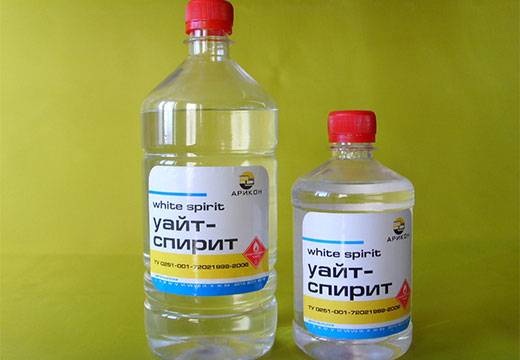
Chemical
When using chemicals on a thick layer of sealant, pre-treat the joints with a rag and remover.
The chemical substance is selected depending on its composition. There are one- and two-component silicones. Acidic is removed with concentrated vinegar or solvent, alcohol is removed with ethyl alcohol, neutral is dissolved with white spirit.
There is another classification of silicones.
- plumbing - used to seal sanitary facilities: acrylic bathtub, shower stall;
- adhesive sealant - used in the manufacture of glass products and glass ceramics: aquariums, stained-glass windows;
- silicones with antifungal additives - used in aquariums, swimming pools.
| Chemical name | Peculiarities |
| White Spirit | Consists of aliphatic and aromatic hydrocarbons. Apply on unpainted surfaces, otherwise the sealant will be removed along with the paint. |
| Penta-840 | A universal solvent for all storage conditions and ambient temperatures. Apply the substance to the required surface, wait for complete softening, rinse with plenty of water. |
| Antisil | Silicone degreaser. |
| Dow Corning OS-2 | Means for removing substances from pvc and acrylic surfaces. |
| Silicon-Entferner | Removes from enamel, metal, plastic surfaces. |
| Lugato Silber Shutz Silicon | In addition to removing it, it prevents the appearance of mold and mildew. |
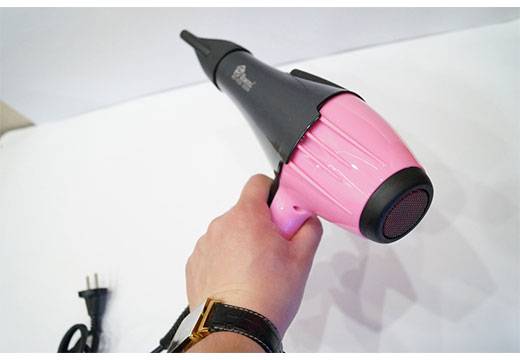
Household methods
fresh stains are removed with a cloth soaked in soapy water. You can clean the brush by soaking it in warm detergent;
the removal method depends on its composition. Neutral seals are made on the basis of alcohol, alkaline - based on alkali, acidic - using acetic acid. To remove, soak the sealant in the material it is based on;
consider the type of surface. It is forbidden to treat wooden kitchen surfaces (countertops) with acetone, white spirit, metal ones - with vinegar (to prevent corrosion);
to get rid of silicone on ceramics, first treat with a solvent, and after half an hour rub the stain;
the easiest way is to wipe old stains off the plastic. It is enough to soak the surface, after half an hour treat it with a solvent, then with a degreasing solution
Use acetone with caution for plastic, there is a possibility of its softening;
removed from metal mechanically (use a knife or scissors);
it is easy to wipe off traces of silicone sealant from glass if you preheat it;
if the sealant needs to be removed from the tile in the bathroom, pick it up with a sharp object and evenly, without sudden movements, remove the substance around the entire perimeter of the tile. If you're worried about scratching the tiles with a sharp object, use a wooden scraper. Degrease the surface first before applying new sealant;
Wrap the salt in cheesecloth and process any type of silicone;
heat the necessary element with a hairdryer, the silicone will fall off on its own from the high temperature.
Degrease the surface first before applying new sealant;
Wrap the salt in cheesecloth and process any type of silicone;
heat the necessary element with a hairdryer, the silicone will fall off on its own from the high temperature.
How to wipe off silicone sealant using folk methods
Popular methods are the most gentle, they are best suited to wipe off the silicone sealant from clothes.
Vinegar essence
The active substance contained in vinegar effectively breaks down the structure of the sticky mass.
To do this, fill the basin with water and add half the package of vinegar essence. Stir the solution, dip the soiled clothes into the basin for half an hour. Wipe off excess sealant with a toothbrush and rub in washing powder. Wash in a washing machine, rinse thoroughly.
Mounting foam
It is necessary to apply a little polyurethane foam to the stain, wait until it dries a little
Shoot carefully, because traces may remain on the problem area. They can be removed with gasoline, then washed in a washing machine and rinsed well.
Alcoholic tincture or vodka
You can wipe off the glass sealant with ordinary vodka or rubbing alcohol. This method is also suitable for removing stains from clothing. Vodka works well for cotton fabrics, while other alcoholic ones can ruin the fabric. To remove the mass, you need to dip a piece of cloth in ordinary vodka and apply it to the problem area. Wait half an hour and clean with a sponge.
Important! Sealant vapors are toxic. Before cleaning, you must open all the windows in the room, it is recommended to wear a respirator.
Freezing things
You can remove the sealant from your clothing by placing it in the freezer. Silicone sealant does not tolerate cold. It is necessary to place the item in a plastic bag, place it in the freezer overnight. In the morning, you need to clean the hardened mass with a blade, remove the excess with plain water and soak in washing powder.
Sunflower oil
Not suitable for all types of sealants, but silicone usually works well. Take regular vegetable oil and heat it up a little in a saucepan. You don't need to use a lot of oil, about 50-100 grams is enough. Do not heat the oil too much, or you will burn your hands. After heating, apply the oil to your hands.
Oil alone will not wash off the sealant. You need to add a little washing powder. You can completely wash your hands with it, or just wipe off the spots with sealant stains. The latter option is preferable because modern powders are very corrosive. After the disappearance of traces of contamination, you should thoroughly rinse your hands with running water.

